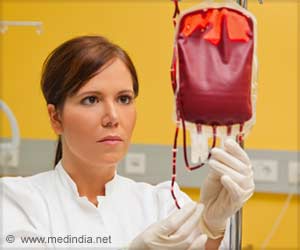Red blood cell transfusions--not plasma--found no higher risk of death in recipients of red blood cells from once-pregnant women.

‘A study of more than 1 million transfusion recipients does not suggest a change in red blood cell donation practices. ’





The research, which used three large donor-recipient databases for its analyses, was funded by the National Heart, Lung, and Blood Institute (NHLBI), part of the National Institutes of Health. The findings appeared online on June 11 in the Journal of the American Medical Association.
Previous studies have suggested that women with a history of pregnancy should be excluded from donating blood products such as plasma, the liquid portion of the blood, because it contains antibodies that pregnant women develop when exposed to fetal blood. The plasma of previously pregnant women has been linked to a potentially lethal complication called transfusion-related acute lung injury (TRALI). The current study of red blood cell transfusions--not plasma--found no higher risk of death in recipients of red blood cells from once-pregnant women.
"NHLBI is charged with conducting and supporting research that improves the blood supply and outcomes in transfused recipients," said Simone Glynn, M.D., M.P.H., chief of the Blood Epidemiology and Clinical Therapeutics Branch at NHLBI. "The results are reassuring in that the survival of patients who got transfused with red blood cells does not appear to be associated with whether the blood they received was donated by a man, by a woman who had been pregnant--or by one who had not. That's important to know."
Scientists analyzed data from the NHLBI-supported Recipient Epidemiology and Donor Evaluation Study-III (REDS-III), a large, multicenter research program focused on ensuring healthy outcomes in donors and transfusion recipients, as well as the safety and availability of transfused blood products in the United States and abroad. Data from the Kaiser Permanente Northern California (KPNC) health care system and the Scandinavian Donations and Transfusions (SCANDAT) database from Sweden and Denmark were also used for the analyses. Together, the three cohorts made available data on more than 1 million patients who had received red blood cell transfusions from 2003 to 2016.
In the KPNC cohort, 9% of the transfusions were from previously pregnant female donors, 39% from never-pregnant female donors, and 44% from donors of the opposite sex of the recipient. In the REDS-III cohort, 18% of transfusions were from female donors who had delivered babies in the past (parous donors), 43% from never-pregnant female donors, and 49% from donors of the opposite sex. In the SCANDAT cohort, 25% of transfusions were from parous donors; 41% from never-pregnant female donors, and 50% from donors of the opposite sex.
Advertisement
Researchers found no significant associations between patient mortality and red blood cell transfusions from either the parous, previously pregnant, and never-pregnant female donors or the donors of the opposite sex. This finding applied to men and women transfusion recipients, regardless of age. Even in the case of female donors who gave birth for the first time during the study period and continued to donate blood--a group analyzed in detail in the SCANDAT cohort--researchers found no effect on the risk of death among patients transfused with their blood.
Advertisement
"We proactively address potential risks to the blood supply, and we take this seriously," said Gustaf Edgren, M.D., Ph.D., study author and senior researcher in the Department of Medicine Solna at Karolinska Institute in Stockholm, Sweden. "Transfusions are very common procedures, and our findings ensure that the current practice is safe and doesn't need to be changed."
Worldwide, more than 80 million units of red blood cells are transfused annually. Roubinian said the study adds to our understanding of blood safety in current transfusion practice, in parallel with work studying how donors are selected, how blood is processed, and how those factors may affect patient outcomes.
The researchers' next goal is to investigate whether other blood donor and component factors could pose medical problems in transfused patients, focusing on chronically transfused groups of adults and pediatric patients.
Source-Eurekalert















